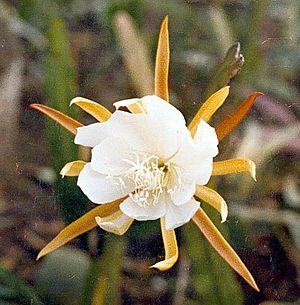Epiphyllum laui facts for kids
Epiphyllum laui is a special type of cactus that grows in Mexico. People often grow it as a beautiful houseplant because of its amazing flowers. It's sometimes called an "orchid cactus" because its flowers look a bit like orchids!
Quick facts for kids Epiphyllum laui |
|
|---|---|
 |
|
| Photo: Alfred Lau | |
| Scientific classification | |
| Genus: |
Epiphyllum
|
| Species: |
laui
|
Contents
What it Looks Like
This cactus has long, flat stems that branch out. The stems are about 5 to 7 centimeters (2-3 inches) wide. They have a clear middle line and wavy edges. Small, brownish-cream spots called areoles hide tiny spines. These spines are thin, like hair, and are usually 3 to 5 millimeters long. The plant's skin is shiny green and smooth. Sometimes, the tips of the stems can look reddish or brownish.
Amazing Flowers
The flowers of Epiphyllum laui are quite large and beautiful! They are about 15 to 16 centimeters (6 inches) long and wide. They open in the evening and stay fully open for two whole days. The flowers are shaped like a funnel. They have many petals. The outer petals are reddish-orange or reddish-yellow. The inner petals are pure white, sometimes with a yellow tint. Inside the flower, you'll find cream-colored stamens (the parts that hold pollen) and a long style (the central part).
Fruits and Seeds
After the flower, the plant grows oblong fruits. These fruits are usually 6 to 8 centimeters (2.5-3 inches) long and 2 to 4 centimeters thick. They are bright carmine red. Inside, the fruit has white flesh that turns pink when it's fully ripe. The seeds are small, black, and shaped like tiny beans, about 2 millimeters long.
Plant Family and History
E. laui is closely related to other cacti like Epiphyllum crenatum and Epiphyllum anguliger. This means they share many similar features.
How it Got its Name
This plant was first discovered in 1975 by a person named Alfred B. Lau. That's why the species is named laui after him!
Its Discovery Story
Even though Alfred Lau found this plant in 1975, it took a while for scientists to officially describe it. This is because the plant didn't flower at the Huntington Botanical Garden, where scientists were studying it. However, it flowered beautifully for Alfred Lau in Mexico and in other plant collections in Europe. So, Myron Kimnach, a plant expert, knew it was a new species. Finally, in 1989, the plant bloomed at Huntington, and Kimnach was able to write its scientific description. He said the plant was "outstandingly attractive."
Where it Lives
You can find E. laui growing naturally in Mexico, specifically in a region called Chiapas. It grows in two interesting ways:
- As a lithophyte: This means it grows on rocks.
- As an epiphyte: This means it grows on other plants, like trees, but it doesn't take food from them. It just uses them for support.
It lives in areas that are quite high up, between 1,800 and 2,000 meters (about 5,900 to 6,500 feet) above sea level.
How to Grow it
E. laui is a fast-growing plant. However, sometimes its stems can start to die back. Myron Kimnach, the scientist, even had to wait 10 years for his plant to flower! But in Europe, it has been easier to grow. When growing E. laui, it seems to like a lot of humidity (moisture in the air) and moist soil. It also prefers cooler conditions. Some plants have even survived temperatures close to freezing in Germany! If you notice parts of the stem dying, it might be due to a plant virus. It's best not to take cuttings from plants that show these signs, to avoid spreading the problem.
See also
 In Spanish: Epiphyllum laui para niños
In Spanish: Epiphyllum laui para niños

